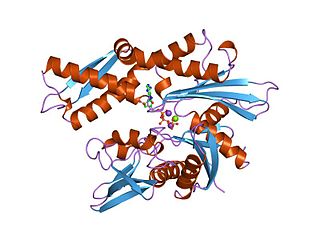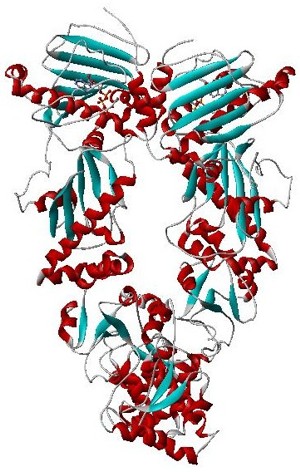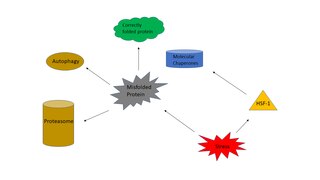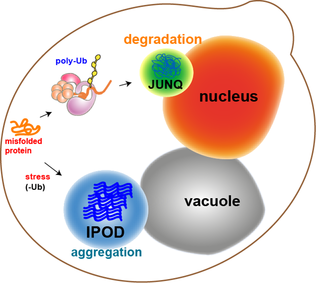Related Research Articles

In molecular biology, molecular chaperones are proteins that assist the conformational folding or unfolding of large proteins or macromolecular protein complexes. There are a number of classes of molecular chaperones, all of which function to assist large proteins in proper protein folding during or after synthesis, and after partial denaturation. Chaperones are also involved in the translocation of proteins for proteolysis.
Heat shock proteins (HSPs) are a family of proteins produced by cells in response to exposure to stressful conditions. They were first described in relation to heat shock, but are now known to also be expressed during other stresses including exposure to cold, UV light and during wound healing or tissue remodeling. Many members of this group perform chaperone functions by stabilizing new proteins to ensure correct folding or by helping to refold proteins that were damaged by the cell stress. This increase in expression is transcriptionally regulated. The dramatic upregulation of the heat shock proteins is a key part of the heat shock response and is induced primarily by heat shock factor (HSF). HSPs are found in virtually all living organisms, from bacteria to humans.

The 70 kilodalton heat shock proteins are a family of conserved ubiquitously expressed heat shock proteins. Proteins with similar structure exist in virtually all living organisms. Intracellularly localized Hsp70s are an important part of the cell's machinery for protein folding, performing chaperoning functions, and helping to protect cells from the adverse effects of physiological stresses. Additionally, membrane-bound Hsp70s have been identified as a potential target for cancer therapies and their extracellularly localized counterparts have been identified as having both membrane-bound and membrane-free structures.

Hsp90 is a chaperone protein that assists other proteins to fold properly, stabilizes proteins against heat stress, and aids in protein degradation. It also stabilizes a number of proteins required for tumor growth, which is why Hsp90 inhibitors are investigated as anti-cancer drugs.

The heat shock response (HSR) is a cell stress response that increases the number of molecular chaperones to combat the negative effects on proteins caused by stressors such as increased temperatures, oxidative stress, and heavy metals. In a normal cell, proteostasis must be maintained because proteins are the main functional units of the cell. Many proteins take on a defined configuration in a process known as protein folding in order to perform their biological functions. If these structures are altered, critical processes could be affected, leading to cell damage or death. The heat shock response can be employed under stress to induce the expression of heat shock proteins (HSP), many of which are molecular chaperones, that help prevent or reverse protein misfolding and provide an environment for proper folding.

Heat shock 70 kDa protein 8 also known as heat shock cognate 71 kDa protein or Hsc70 or Hsp73 is a heat shock protein that in humans is encoded by the HSPA8 gene on chromosome 11. As a member of the heat shock protein 70 family and a chaperone protein, it facilitates the proper folding of newly translated and misfolded proteins, as well as stabilize or degrade mutant proteins. Its functions contribute to biological processes including signal transduction, apoptosis, autophagy, protein homeostasis, and cell growth and differentiation. It has been associated with an extensive number of cancers, neurodegenerative diseases, cell senescence, and aging.
In eukaryotic cells, an aggresome refers to an aggregation of misfolded proteins in the cell, formed when the protein degradation system of the cell is overwhelmed. Aggresome formation is a highly regulated process that possibly serves to organize misfolded proteins into a single location.

In medicine, proteinopathy, or proteopathy, protein conformational disorder, or protein misfolding disease, is a class of diseases in which certain proteins become structurally abnormal, and thereby disrupt the function of cells, tissues and organs of the body. Often the proteins fail to fold into their normal configuration; in this misfolded state, the proteins can become toxic in some way or they can lose their normal function. The proteinopathies include such diseases as Creutzfeldt–Jakob disease and other prion diseases, Alzheimer's disease, Parkinson's disease, amyloidosis, multiple system atrophy, and a wide range of other disorders. The term proteopathy was first proposed in 2000 by Lary Walker and Harry LeVine.
Co-chaperones are proteins that assist chaperones in protein folding and other functions. Co-chaperones are the non-client binding molecules that assist in protein folding mediated by Hsp70 and Hsp90. They are particularly essential in stimulation of the ATPase activity of these chaperone proteins. There are a great number of different co-chaperones however based on their domain structure most of them fall into two groups: J-domain proteins and tetratricopeptide repeats (TPR).

Heat shock protein HSP 90-alpha is a protein that in humans is encoded by the HSP90AA1 gene.

Heat shock factor 1 is a protein that in humans is encoded by the HSF1 gene. HSF1 is highly conserved in eukaryotes and is the primary mediator of transcriptional responses to proteotoxic stress with important roles in non-stress regulation such as development and metabolism.

Heat shock protein HSP 90-beta also called HSP90beta is a protein that in humans is encoded by the HSP90AB1 gene.
Jeffery W. Kelly is an American businessman and chemist who is on the faculty of the Scripps Research Institute in La Jolla, California.

In molecular biology, protein aggregation is a phenomenon in which intrinsically-disordered or mis-folded proteins aggregate either intra- or extracellularly. Protein aggregates have been implicated in a wide variety of diseases known as amyloidoses, including ALS, Alzheimer's, Parkinson's and prion disease.
Richard I. Morimoto is a Japanese American molecular biologist. He is the Bill and Gayle Cook Professor of Biology and Director of the Rice Institute for Biomedical Research at Northwestern University.
Proteostasis is the dynamic regulation of a balanced, functional proteome. The proteostasis network includes competing and integrated biological pathways within cells that control the biogenesis, folding, trafficking, and degradation of proteins present within and outside the cell. Loss of proteostasis is central to understanding the cause of diseases associated with excessive protein misfolding and degradation leading to loss-of-function phenotypes, as well as aggregation-associated degenerative disorders. Therapeutic restoration of proteostasis may treat or resolve these pathologies.

An Hsp90 inhibitor is a substance that inhibits that activity of the Hsp90 heat shock protein. Since Hsp90 stabilizes a variety of proteins required for survival of cancer cells, these substances may have therapeutic benefit in the treatment of various types of malignancies. Furthermore, a number of Hsp90 inhibitors are currently undergoing clinical trials for a variety of cancers. Hsp90 inhibitors include the natural products geldanamycin, Retaspimycin hydrochloride and radicicol as well as semisynthetic derivatives 17-N-Allylamino-17-demethoxygeldanamycin (17AAG).

JUNQ and IPOD are types of cytosolic protein inclusion bodies in eukaryotes.
Chemical chaperones are a class of small molecules that function to enhance the folding and/or stability of proteins. Chemical chaperones are a broad and diverse group of molecules, and they can influence protein stability and polypeptide organization through a variety of mechanisms. Chemical chaperones are used for a range of applications, from production of recombinant proteins to treatment of protein misfolding in vivo.

Zihai Li is a board-certified medical oncologist, cancer immunologist, and leader in academic medicine. He was recruited to Ohio State University Comprehensive Cancer Center – The James Cancer Hospital & Solove Research Institute (OSUCCC) in 2019 as the founding director of the Pelotonia Institute for Immuno-Oncology. He is a professor of medicine in the Division of Medical Oncology, holds the Klotz Memorial Chair for Cancer Research, and was appointed in 2023 as deputy director for translational research at OSUCCC.
References
- ↑ Balch WE, Morimoto RI, Dillin A, Kelly JW (Feb 2008). "Adapting proteostasis for disease intervention". Science. 319 (5865): 916–919. Bibcode:2008Sci...319..916B. doi:10.1126/science.1141448. PMID 18276881. S2CID 20952037.
- ↑ Douglas, P. M.; Summers, D. W.; Cyr, D. M. (2009). "Molecular chaperones antagonize proteotoxicity by differentially modulating protein aggregation pathways". Prion. 3 (2): 51–58. doi:10.4161/pri.3.2.8587. PMC 2712599 . PMID 19421006.
- ↑ Wang X, et al. (2006). "Hsp90 cochaperone Aha1 down regulation rescues misfolding of CFTR in cystic fibrosis". Cell. 127 (4): 803–15. doi: 10.1016/j.cell.2006.09.043 . PMID 17110338. S2CID 1457851.
- ↑ Brehme M, et al. (2014). "A conserved chaperome sub-network safeguards protein homeostasis in aging and neurodegenerative disease". Cell Rep. 9 (3): 1135–1150. doi:10.1016/j.celrep.2014.09.042. PMC 4255334 . PMID 25437566.
- ↑ Brehme M, Voisine C (2016). "Model systems of protein-misfolding diseases reveal chaperone modifiers of proteotoxicity". Dis. Models Mech. 9 (8): 823–38. doi:10.1242/dmm.024703. PMC 5007983 . PMID 27491084.
- 1 2 Chiosis, Gabriela; Guzman, Monica L.; Lewis, Jason S.; Larson, Steven M.; Melnick, Ari; Levine, Ross; Cerchietti, Leandro; Cesarman, Ethel; Roboz, Gail J. (October 2016). "The epichaperome is an integrated chaperome network that facilitates tumour survival". Nature. 538 (7625): 397–401. Bibcode:2016Natur.538..397R. doi:10.1038/nature19807. ISSN 1476-4687. PMC 5283383 . PMID 27706135.
- ↑ Chiosis, Gabriela; Gewirth, Daniel T.; Guzman, Monica L.; Modi, Shanu; Corben, Adriana; Dunphy, Mark P.; Rodina, Anna; Wang, Tai (2019-02-08). "Chaperome heterogeneity and its implications for cancer study and treatment". Journal of Biological Chemistry. 294 (6): 2162–2179. doi: 10.1074/jbc.REV118.002811 . ISSN 0021-9258. PMC 6369301 . PMID 30409908.
- ↑ Chiosis, Gabriela; Brodsky, Jeffrey L.; Sahil Sharma; Araujo, Thaís L. S.; Wang, Tai; Joshi, Suhasini (September 2018). "Adapting to stress — chaperome networks in cancer". Nature Reviews Cancer. 18 (9): 562–575. doi:10.1038/s41568-018-0020-9. ISSN 1474-1768. PMC 6108944 . PMID 29795326.